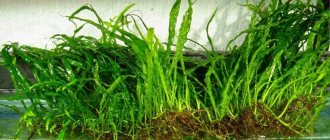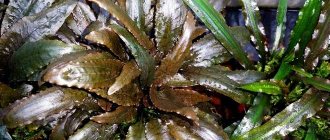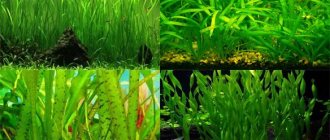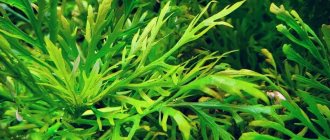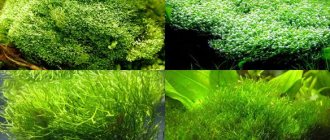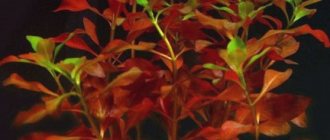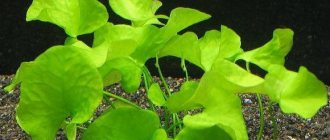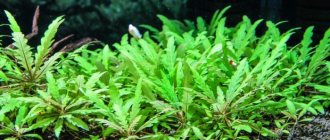Cryptocoryne is a plant from the Araceae family. They are very popular among aquarists due to the fact that they are quite easy to care for.
Beginning aquarists very often choose cryptocorynes, this allows them to gain experience and the necessary knowledge in caring for aquarium plants.
A special feature of Cryptocoryne is its structure. The root is located under the water column, but the flower grows above the water, shaped very similar to a musical instrument. In its natural habitat it grows near trees, which means it has excellent tolerance to dim light.
Bloom
The inflorescences of the algae have a small shape. They have an unusual structure that distinguishes them from other bottom plants.
It does not bloom actively and reluctantly.
In order to provoke this process artificially, it is necessary to provide bright twelve-hour lighting, as well as increase the water temperature by a couple of degrees. After a few months, the algae will show rare and beautiful flowers.
- There is another way to influence the plant. To do this, you will need a small flower pot, the diameter of which will not exceed 7-8 cm.
- Garden soil is poured into the bottom. It is important that it does not contain lime.
- Peat is laid on top and the plant is planted.
- The soil is well filled with water, after which a pot is placed in it.
- Ideally, it would be possible to heat the soil using a bottom heater.
Shape and color
Cryptocoryne is a bush with a rosette of 5-15 leaves, the rhizome is located horizontally. The leaves are entire, their shape varies depending on the type of plant: from lanceolate to ovate. The color of the leaves ranges from bright green and olive to brownish, and in prolonged low light they turn red. The inflorescence is small, often has a bizarre shape and color, and is transformed into a tube-like shape. The tube is partially immersed in water, but is waterproof, its length is 1-3 cm. Inside the tube there is a cob, protected from exposure to water.
Lighting
Cryptocoryne is a light-loving plant. However, excessive amounts of ultraviolet radiation can cause dry leaves and the appearance of disease on them. Therefore, a glow intensity of 0.5 W/l is ideal. At the same time, both fluorescent and LED lamps can be used.
Some species of Cryptocoryne, brought from tropical countries, need bright light.
Excessive lighting will cause the plant's leaves to turn deep red instead of green.
Maintenance and care
The plant has a large number of species, all of them are as unpretentious as possible. They receive all nutrients through the roots; the basic and main rule is to thoroughly fertilize the soil. They easily tolerate a lack of light and a minimal amount of carbon dioxide.
Almost all species make do with a small amount of light. Strong light can cause leaves to turn intense colors from green to red and purple. This does not cause any harm, but it can spoil the overall picture. Absolutely all types are extremely sensitive to water temperature and its hardness. To create convenient conditions for growing a plant, it is necessary that the water temperature is at least 22° C, and the hardness does not exceed 16° dH, and the acidity is from 6.5-7.5 pH.
The plant receives all nutrients through the root system. Silty soil is ideal for such roots, but it is necessary to take care of a nutritious substrate to ensure the most comfortable growth.
It is worth paying attention to the fact that cryptocorynes most often do not tolerate transplantation from place to place. Therefore, it is recommended to carefully calculate in advance the place where the plant will be planted.
Water
The plant grows along the banks of warm tropical reservoirs. This means it needs appropriate water temperature. The minimum temperature must not be lower than 22 °C. Otherwise, the cryptocoryne bushes will begin to get sick and will soon die.
The ideal indicator is in the range from 24 to 28 °C.
Before purchasing, be sure to consider whether this temperature will be comfortable for other inhabitants of the aquarium.
Water hardness should also be no higher than 10 – 11° dGH. Acidity is measured individually. It is important that the indicator is normal.
Habitat
The cryptocoryne plant is found in water bodies of tropical and subtropical zones of South and Southeast Asia. And equally often in reservoirs with stagnant water and rivers with slow and fast currents. There is a lot of cryptocoryne in the marshy places of the island of Sri Lanka, New Guinea, the Moluccas, India, Taiwan and Vietnam. Prefers shaded areas of rivers and streams flowing through damp tropical forests.
Fertilizer
Like any other plant, cryptocoryne needs nutrition for enhanced growth. Aquarists advise using solid fertilizers that can easily be placed in the soil. Their peculiarity is that they do not dissolve in water and do not pollute it.
In some situations, it is possible to use liquid fertilizer solutions. The main thing is that they are based on distilled water. Macro and microelements are dissolved inside, useful not only for plants, but also for all inhabitants of the aquarium.
Possible problems
Cryptocoryne does not tolerate transplants and sudden changes in habitat. Therefore, it is important to immediately decide on the location of the plant, and also to ensure that acidity, water hardness, temperature and lighting are maintained at an even level.
Otherwise, the risk of developing cryptocoryne disease increases significantly. This disease affects the leaf blades of the plant, making them soft, pale, and thin. As the pathological process progresses, the leaves of Cryptocoryne completely dissolve.
When the first symptoms characteristic of cryptocoryne disease are detected, it is recommended to thoroughly clean the soil, completely replace the water in the aquarium, and remove affected specimens and damaged leaf blades.
The following factors can trigger the development of cryptocoryne disease:
- use of poor quality water;
- introduction of sick fish that infect aquarium crops;
- changing the aquarium design with accompanying plant transplantation.
The plant tolerates hard water and insufficient lighting. However, it should be remembered that with a lack of light, the leaves fade and lose their beauty.
Diseases and prevention
Improper care or temperature conditions can cause various diseases. Often the algae develops “cryptocoryne disease.” It occurs during the cold season. The water temperature becomes lower, which directly affects the appearance of the plant. The leaf becomes dry, loses pigment, and becomes thinner. Decomposition processes gradually begin. These diseases are provoked by changes in conditions in the aquarium. For example, the water has become harder, colder, the lighting is not as bright, the filtration system is not working well, or chemicals have entered the water.
Important!
Sometimes the disease is transmitted to Cryptocoryne from new plants that have just been placed in water.
If the aquarist notices such processes, he should immediately remove the plant from the aquarium in order not to infect the entire flora. It will no longer be possible to save the leaves if some of them have undergone the process of decomposition. But the roots can still be revived. To do this, they are freed from leaves, placed in clean water and cleared of soil. After being quarantined for several children, the plant comes to its senses and begins to grow.
The following types of cryptocorynes are most often susceptible to diseases: Beckett, Related, Wendta.
All Cryptocoryne species prefer soft water
Planting and propagation
Cryptocorynes grow slowly and do not like frequent transplants , so the place for the hydrophyte must be chosen carefully in the aquarium so as not to move the bushes later.
Cryptorina is propagated vegetatively, since it is difficult to achieve flowering at home.
Reproduction occurs:
- dividing the bush;
- root layering.
What plants can be planted with cryptocoryne?
Perhaps, problems can arise only in the vicinity of Vallisneria, since it prefers more shaded bodies of water.
But in general, the problem of a “complex” neighborhood can be easily solved by competent zoning and planting in accordance with it.
View this post on Instagram
Posted by @katina_happy_succulent March 3, 2021 at 10:36 PST
Fish
Cryptocoryne gets along well with your favorite fish species. Therefore, there is no need to select neighbors. However, some active species of cichlids often behave too aggressively during the spawning period and can tear up the soil. This releases the roots, disrupts the nutrition process and can cause the death of the plant.
Cryptocoryne does not suffer from the fact that some species, for example, scrofula, can feast on the leaves. This stimulates increased growth and does not cause serious damage.
Cryptocorynes on the island of Sumatra
Information about the distribution of cryptocorynes on the island of Sumatra is rather scarce. Researchers have discovered nine plant species here: C. pontederiifolia, C. longicauda, C. scurrilis, C. diderici, C. jacobseni, C. gasseri, C. villosa, C. amicorum and C. moehlmannii. On the south west coast of the island, C. pontederiifolia and C. moehlmannii grow in intertidal zones similar to the habitats of C. ferruginea in Malaysia. Cryptocoryne species have been found in the moist evergreen forests of the northeast coast . The biotopes here are similar to those from the southern regions of Malaysia: slowly flowing streams and rivers located in the dense shade of tree crowns, acidic soils with significant deposits of silt and leaf litter in places with weak currents, and with clean sand in rapids. In the vicinity of Abai Siat there are small populations of C. villosa, which have chosen abandoned rubber plantations.
Another natural biotope for cryptocorynes
Cryptocoryne species
In total, there are more than two dozen varieties of cryptocorynes. They differ from each other in shape, color, and growing conditions. Photos of cryptocorynes and a detailed description will help you understand the species in detail. Some also grow in the wild. Others are bred through selective breeding.
Nuri
A common rosette plant that perfectly adapts to life and growth in an aquarium. The ripening rate is very slow, so purchasing this species “for growth” is not advisable. One of the latest species of cryptocorynes.
An excellent decorative element, therefore it is often planted in the foreground. Malaysia is considered the homeland. Loves shallow waters and high temperatures.
It has a highly developed root system, so it stays in the soil better than other fellows and even resists aggressive cichlids. The average height is from 10 to 15 cm. The leaves are ovoid and narrow. Sometimes their shape can resemble a heart.
The length of the leaf can reach 30 cm. The color is also different, and largely depends on the characteristics of the water. It can be yellow-green, red, green, brown-brown.
The plant does not require special care; the optimal temperature is considered to be 25 °C. Loves running clean water.
Note!
In order to speed up the growth of the plant, it is necessary to remove it from the water and grow it in the open air. If care and fertilizers were applied in a timely manner, once a year it will delight the owners of the aquarium with its incredible flowering.
Aquarium Cryptocoryne nuri is a rather rare plant among aquarists.
Balance
This species is widespread in Thailand, southern Vietnam, India and China. One of the most popular plants for the aquarium. It is distinguished by its appearance, which allows the plants to be used as decoration. Easy to care for and unpretentious. It grows evenly, but not very quickly.
Leaves are corrugated. They have an elongated shape. In case of timely fertilization and proper care, they reach a length of 50 cm. The shape of the leaf adapts to the shape and size of the aquarium. In order to get spreading bushes, it is better to place them in high tanks.
Grows well next to side walls. The root system is poorly developed, so cichlids often dig up cryptocoryne.
The ideal temperature is 26 °C. Water hardness is from 6 to 16. Requires moderate lighting, but for flowering it will have to be increased. Loves nutritious soil.
Cryptocoryne balance has high decorative qualities and is easy to care for.
Reverse spiral
The plant is common in Asia, particularly on the west coast of India. Also found on the island of Bali.
It grows along the banks of rivers and lakes and becomes very elongated during the rainy season.
It has been known in Russia for a long time; this is one of the first species of cryptocorynes that was imported for sale.
With proper care, the plant can reach 50 cm in height. The leaves have a narrow and ribbon-like shape. The surface of the sheet is very smooth, but sometimes, if the water is too hard, it can be wavy.
Cryptocoryne got its name due to the fact that sometimes its leaves begin to twist into bizarre spirals.
Likes water temperatures between 24 and 26 °C. It is advisable to follow the care recommendations and water parameters (hardness).
Reacts poorly to changes in the acidity of the liquid, and can quickly get sick if the acidity exceeds the established norm.
On a note!
It grows well in nutritious soil and is not very demanding of light.
The plant is quite tall, so it is ideal for decorating medium and specified areas.
Curly
Cryptocoryne curly is a plant found only in the very south of Thailand. It settles along reservoirs flowing next to limestone mountains. Therefore, it is undemanding regarding water hardness.
The leaves reach a length of 20 to 60 cm. The rosette grows up to 20 cm in width. It is often used as a decorative element, and also allows fish to hide from bright daylight.
The growth rate is average and moderate. The content is not complicated at all. The optimal temperature is 20 to 27 °C.
Loves soil that is rich in nutrients. Ideally, it should contain sand, pebbles, and limestone. When moving to a new aquarium, in order to provoke active growth, it is important to actively introduce feeding. For example, mineral fertilizers. Ideally, administer them once a week.
Under natural conditions, Cryptocoryne curly grows in water bodies with increased water hardness.
Affinis (related)
Cryptocoryne akin is a herbaceous aquarium plant that is extremely popular and incredibly showy. Reproduces vegetatively. In order for growth to be active, it is important to provide silty soil.
If all conditions are met, cryptocoryne affinis can reach a height of 35 cm. It is recommended to plant in the side parts of the tank.
Permissible temperature 20 to 25 °C. If the thermometer drops below 20°, the plant begins to die. Acceptable hardness is from 7 to. If the water is soft, the plant will begin to actively shed its leaves. It requires lighting; with a lack of light, the shoots become dark and quickly fade.
Advice!
It is recommended to plant affinis on nutritious soil with peat elements. Ideal if it is heated.
For better growth of this subspecies of cryptocorynes, a high degree of silt in the soil is important.
Flamingo
A unique plant that has a pink tint. It cannot be found in the wild; the variety was bred through selective breeding. It is grown only in nurseries and sold for sale in special tanks. An expensive pleasure, it needs careful care. An adult bush can reach up to 25 cm, but growth is very slow. The rosette includes five leaves.
In poor lighting it quickly darkens and acquires a dark brown tint. The optimal water temperature is about 26 °C. Hardness from 1 to 18°. Acidity is moderate.
The indicators inside the aquarium should be at the same level. If any fluctuations occur, the plant will quickly begin to shed its leaves. Prefers soil that is nutritious but shallow.
Cryptocoryne Flamingo - a beautiful plant with pink leaves, bred through selective breeding
Aponoghetonolifolia
One of the most popular and spectacular types. It has corrugated leaves of a light green hue. In aquariums it grows quickly, reaching a height of up to 60 cm. Suitable only for high tanks.
Does not require bright lighting, water temperature is 27 °C. Liquid from 6 to 16°.
Important!
The temperature must not drop below 24 °C. In this case, the plant will begin to quickly shed its leaves.
Cryptocoryne aponoghetonolifolia is rightfully considered one of the most beautiful representatives of the genus
Yellow
Walker's Cryptocoryne. It is considered one of the most unpretentious in terms of living conditions. In an aquarium it grows up to 20 cm in height. It can be planted both on the sides and in the middle. Color varies from green to brown. Sometimes it turns yellowish-green. The edge of the leaf can be wavy, but if there is no strong current, it is smooth. He loves soft water, but if the hardness level is slightly too high, there is nothing to worry about. The temperature range is from 24 to 28 °C. It endures changes with endurance.
Cryptocoryne Walker is one of the most resistant representatives of the genus to adverse conditions
Wendt
Most often grows in Sri Lanka. It got its name in honor of the German botanist who first discovered plants. Popular with aquarists. It looks impressive, however, they occupy the entire area, as they grow very slowly. The leaves reach 15 cm in length. They have an elongated shape, crowned with a sharp tip. The plant reaches a width of up to 3 cm. It loves bright light, which allows it to grow in height. The coloring of this species varies depending on water characteristics and lighting. This is what makes him unique.
Cryptocoryne Wendta ideally combines decorative appearance and optimal growth
Parva
Sri Lanka is the birthplace of this species. Loves high water temperatures up to 30 °C and hardness from 2 to 16 °. It grows up to 10 cm in height and up to 7 cm in width. It is a fairly wide shrub, but not tall. It grows very slowly. It is considered a dwarf species that is demanding on lighting. If there is not enough light, it will hurt and rot.
Cryptocoryne parva is the smallest of all cryptocorynes.
Neville
Like its predecessor, it is found in Sri Lanka. It is small in size. The height does not exceed 20 cm. Bushes can have both long and very short leaves. Has a bright green tint. The brighter the lighting, the more vibrant the color will be.
It grows slowly, only one new leaf can be counted in a month. The roots are strong and sit well in the soil. Thanks to its root system, the species tolerates the lack of nutrients well. Not afraid of temperature fluctuations.
Description
In nature, this plant is found mainly on the islands of Southeast Asia. These are mainly swamps or small rivers that experience droughts. The bushes are completely in water. Only flowers are visible above the surface. Cryptocoryne is found primarily under large trees in tropical climates. Therefore, she prefers warm water and easily tolerates diffused lighting.
Cryptocoryne appeared in aquariums in the first half of the 19th century. Since then, breeders have constantly developed new varieties. Some hobbyists can find up to several dozen species in one container. Therefore, it is sometimes extremely difficult to determine the variety. Especially when you consider that the leaves can change shape and color depending on the conditions.
This unpretentious aquarium plant feels great even under average conditions. It does not need a supply of carbon dioxide, water using reverse osmosis technology, etc. It takes root easily and grows even in poor lighting. Bushes receive most of their nutrition through their roots. Therefore, the main thing is that there are enough substances in the soil.
Cryptocoryne has long leaves, the size of which varies depending on the species. It can vary from a couple of centimeters to a whole meter. From one rosette grows up to 15 leaves, green, olive or brown. The root system is well developed. Under good conditions, the bush sends out an arrow, from which a baby is formed.
Cryptocoryne Petch
It should also be taken into account that this underwater flora is characterized by “cryptocoryne disease”. It often appears in winter. The leaves become soft and begin to dissolve. Usually an aquarist encounters this phenomenon when he abruptly changes the conditions of detention. That is, the fillers in the filter were changed, there was a jump in the water parameters, the lamp changed, etc. In this situation, the main thing is to preserve the rhizome. If the leaves have completely disappeared, this does not mean that the plant has died. If the root is intact, conditions need to be normalized and then new shoots will quickly appear.
Video : What is cryptocoryne disease, treatment of aquarium plants.
How to choose a plant
In order to choose a plant, you need to analyze the characteristics of your aquarium. Everything matters:
- form;
- size;
- the soil that is used;
- aquarium inhabitants;
- hardness of water;
- temperature.
The technical characteristics of the aquarium must be compared with the favorable conditions for the development of the type of cryptocoryne that seems most optimal to you.
Important!
The height of the aquarium should be no less than the average size of the bush.
How to plant cryptocoryne
To properly plant Cryptocoryne, you will need the following instructions.
Preparing the soil for planting
It is necessary to decide on the type of soil. Each individual species requires a specific approach. In one case, the bottom should be muddy, in another – peat, in the third, nutritious soil is also suitable.
It should be laid at a height of five to six centimeters, depending on how developed the rhizome of the plants is.
After the soil has been laid out on the bottom, it must be crushed well and allowed to sit in water for some time. At this point, it is better to remove the inhabitants of the aquarium.
The influence of peat on plant maintenance
It is believed that peat is a useful substance that helps the plant actively grow and develop. However, the abundance of peat strongly acidifies the soil, which is detrimental to some species of cryptocorynes.
Therefore, when adding such an ingredient, you should not overdo it. Be sure to let the water settle and measure the acidity level. It should be within reasonable limits.
Aquarium decoration
"Crypt" provides many benefits if planted correctly. Many aquarists call it a plant for the lazy. This is explained by the fact that this underwater flora loves old aquariums, where the water parameters are stable, the soil has a lot of nutrients and, in general, the owner does not need to create anything special in order for the new bushes to take root.
Cryptocoryne is presented in a wide variety. Varieties differ in color, shape, size, number of leaves, etc. Thanks to this, it can be widely used in various design options, and often even some aquarists use exclusively this underwater flora for aquascapes.
Often "crypts" are used as a solitaire. That is, the aquarium contains a minimum of decorative elements and only one bush, but of a large size. It attracts all attention and the main emphasis is placed on it.
In general, Cryptocoryne is used in the following types of aquariums:
Dutch design . Some aquarists consider this style already classic, since it has lost its popularity to other directions. However, it still remains relevant today. In Dutch aquariums it is common to use a lot of flora. However, the main rule is that it should be varied. Accordingly, cryptocoryne will have to be combined with other flora that differ in leaf shape and other indicators. For example, it can be combined with nymphea, echinodorus, ground cover plants, etc. At the same time, it is important to follow the rules of the golden ratio, asymmetry and other nuances characteristic of this style;
We recommend reading the article: Principles of composition in a Dutch aquarium
Paludariums . The main feature of such containers is that they are only partially filled with water. However, the entire space is decorated. That is, there should be vegetation above the surface. Cryptocoryne is quite capable of coping with this task. The main thing is that the paludarium maintains a high level of humidity, warm water and a good substrate;
Aquarium herbalist . This is a fairly broad concept, since it implies the active use of underwater flora to decorate the aquarium. In this case, everything depends on the taste of the aquarist and his skills in planting plants and observing the classical rules of aquadesign. If we are talking about a natural aquarium, then tropical plants that are found in reservoirs of Southeast Asia should also be planted next to the “crypt”. It will not be difficult to select them, since in these regions the flora is diverse, and thanks to similar climatic conditions, it will not be difficult to achieve normal living conditions.
As for planting in the foreground, middle or background, everything depends directly on the variety itself. There are species that can reach up to 1 meter in height. Accordingly, their place is only at the back wall or in the corner. And, for example, Cryptocoryne Wendt is quite suitable for planting near the front glass. It does not grow along the bottom, but still will not cover the background.
How to keep
Keeping Cryptocoryne will not cause much trouble.
- Check temperature, fluid and acidity readings daily.
- This plant loves clean water, so it is recommended to change it in the aquarium once a week by one quarter.
- Before adding new plants, it is recommended to keep them in quarantine for some time. If after two weeks the plants perform well, they are planted in the main aquarium.
- Once a week, cryptocoryne must be fed with appropriate fertilizers that are characteristic of its species.
- If the algae has suffered any illness, almost immediately, it is necessary to urgently separate all the affected parts and also change the water.
Under the right conditions, the plant can delight with its appearance for a long time.
Cryptocoryne pontederifolia or Cryptocoryne pontederifolia
Moderately whimsical and quite popular aquarium plant.
Genus: Cryptocoryne
Family: Araceae
Habitat: freshwater plant of the island of Sumatra.
Appearance: herbaceous bush, without stem. The leaves of Cryptocoryne are wide, heart-shaped, pointed at the tip, united by a rosette. The leaf blade is light green on the outside, and red-pink on the inside with veins. The leaves are much shorter than the petioles. The height of the bush is 20-25 cm.
Root system: well developed, represented by a horizontal rhizome.
Soil: nutritious, rich in organic matter, with the addition of clay and peat. Soil thickness is 6-7 cm. During the period of active growth, it is advisable to feed the plant with nitrogen fertilizers.
Lighting: bright. Moderate lighting is allowed, but the plant will lose its decorative effect, the leaves will be pale and elongated. The best option for lighting: an LB fluorescent lamp in combination with an incandescent lamp, the total power of which should be 1.0-1.2 W per 1 liter of water. Daylight hours are 12 hours.
Water parameters:
Comfortable temperature: 22-28 °C.
“Acidity” Ph: 6.5-7.5.
Hardness dКH: 6–20 °.
It is necessary to monitor the acidity level of the water, as the plant is susceptible to “cryptocoryne disease”.
Placement in the aquarium: Cryptocoryne pontederifolia should be provided in a tropical aquarium and it is better to place it in the middle of the pond.
Reproduction: vegetative, by rhizome layering.
Cryptocoryne pontederifolia is a plant that prefers marshy areas, so it does well in a humid greenhouse and tropical paludarium.
Breeding
Reproduction of individual species of cryptocorynes is almost impossible. Therefore, you should build on the characteristics of your species.
If this is possible, use the vegetative method.
- To do this, a new shoot that has just appeared is cut from the mother bush, at the moment when it has already gained strength and up to six leaves have appeared on it.
- After this, it is carefully isolated and transplanted into a separate tank.
- When the plant takes root, it can be introduced into a new aquarium.
Fact!
Reproduction through seeds is a very complex and painstaking process that rarely gives results.
Cryptocorynes in Peninsular Malaysia
The waters of Malaysian reservoirs in which cryptocorynes are characterized by low hardness and pH. In aquarium conditions, in hard water, plants from this region become smaller and degrade. Cryptocoryne affinis has colonized the northern and central parts of the peninsula, where it grows in fast-flowing rivers. Even at low water levels it forms large, powerful bushes. This plant is characterized by active vegetative propagation, as a result of which a dense “carpet” is formed. On numerous tangled rhizomes, which serve as a kind of barrier, deposits of sand brought by the current are formed. Unlike Cryptocoryne affinis, Cryptocoryne elliptica has a very narrow range located in silty forest lowlands. This plant is highly dependent on the surrounding forest, and is therefore extremely vulnerable to deforestation.
Сryptocoryne affinis in a natural pond
Cryptocoryne minima comes from rainforests in the west and north-west of the peninsula. It grows in small streams, but the largest specimens are found in forest swamps covered with abundant leaf litter. In the south of Thailand, in the Phuket area, Cryptocoryne cordata, Cryptocoryne schulzei, Cryptocoryne nurii, Cryptocoryne griffithii and Cryptocoryne purpurea are found.
Cryptocoryne elliptica in nature
An interesting biotope of Cryptocoryne purpurea was also discovered here. This is a huge swamp, fed from springs with very acidic water rich in humic compounds. In the canals, at a depth of 1-2 meters, clumps of Cryptocoryne purpurea grow from 30 to 50 cm in height. It is believed that this is the largest accumulation of this species of cryptocoryne . Not so long ago, in 1996-1999, a joint Japanese-Malaysian expedition studied Cryptocoryne purpurea in its natural habitats. Scientists have come to interesting conclusions. Firstly, according to their data, this endemic cryptocoryne is probably no longer found anywhere except the Tasek Vega Ramsar swamp. Secondly, it turned out that the pollen of Cryptocoryne purpurea is sterile, and this species does not form seeds. Perhaps this is the reason that its distribution area is so small.
Why isn't it growing?
Cryptocoryne is a plant that grows incredibly slowly. However, if a plant lives for years and does not grow, this means that some characteristics are not conducive to the process.
It is necessary to determine the variety of cryptocoryne, study the parameters of hardness, acidity, temperature and light, which are required for active growth and development. Compare with those available in the aquarium. In order to provoke a growth spurt, it is enough to increase the temperature by a few degrees.
Reproduction of an aquarium plant
Cryptocoryne reproduces vegetatively - by parts of shoots. A new shoot is formed on the mother plant and is a small shoot with leaves. It can be separated when the number of leaf blades reaches five. The most suitable time for reproduction is spring or autumn.
Many experienced aquarists use the cutting method. To do this, tear off a branch or shorten the main stem, wait until the cutting sprouts roots and place it in the substrate. You can also try simply pinching a section of the plant with a pebble and waiting for it to take root.
Reviews
Cryptocoryne will become a real decoration of the aquarium, saturating the water with oxygen. The algae will give the fish a place to hide and will become a stunning decorative element, effectively emphasizing the parameters of the tank. In order for the plant to be happy for as long as possible, it is important to find the right approach to caring for it.
Would you like to purchase Cryptocoryne for your own aquarium? Share in the comments!
Disease resistance
A factor that upsets many aquarists is the high susceptibility of such aquarium inhabitants to disease. The most susceptible are Cryptocoryne cordata and Cryptocoryne lucidum. But Cryptocoryne pontederifolia and Cryptocoryne spirala also do not stand aside. When unfavorable microflora enters the aquarium, the leaves of plants soften, change their color up to yellowing (for example, Cryptocoryne Walker), they can curl longitudinally and over time, separating from the general bush, float to the surface. This may be the case:
- Topping up or replacing unreliable water;
- Planting a new plant affected by bacteria;
- Introducing unhealthy fish;
- Carrying out new design and other
Whatever choice is made, it is worth complementing the design with options such as Cryptocoryne lucidum and Cryptocoryne nuri. And the originality of the Cryptocoryne spiral bush will always attract attention.
An aquarium with original plant compositions is a worthy decoration for any home, and the correct selection of their options is a guarantee of the health of your favorite underwater world and its inhabitants. Therefore, you should not rely on “maybe”; it is better to immediately take into account all the nuances and admire the fruits of your labor.
Post Views: 18,075
